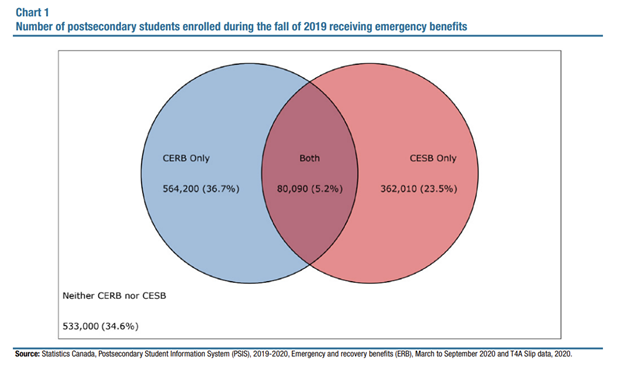Last week, Statistics Canada published a fascinating little report on how much assistance Canadian students received from the Canada Emergency Response Benefit (CERB) and the Canada Emergency Student Benefit (CESB) during COVID. The results are interesting but lack a bit of context, which I thought I would provide.
It’s been nearly three years since CERB and CESB were a thing, so here’s a refresher: CERB was announced on March 25 just a few days after much of the economy came to a screeching halt after the first stay-at-home orders and ended about six months later. It was available to Canadian residents who stopped working because of reasons related to COVID-19 or were eligible for Employment Insurance regular or sickness benefits or had exhausted their Employment Insurance regular benefits or Employment Insurance fishing benefits between December 29, 2019 and October 3, 2020. It was, however, not available to those who quit their job voluntarily, or to those who had employment and/or self-employment less than $5,000 in 2019 or in the 12 months prior to the date of their application.
A lot of students would have qualified for CERB. Around 40% of students work part-time at any given point in the school year, and at $15/hour, one only needed to work 333 hours over 12 months to cross the threshold. Those who met this threshold received $2000 every 4 weeks, or probably somewhere just north of $8000 for the summer.
For students who did not qualify for CERB, there was the CESB. For this you needed to be a Canadian citizen or permanent resident (so, a slightly tighter criteria than CERB), to have been enrolled in a PSE program when the pandemic hit or graduated in 2019 or later, or have graduated from high school and have applied to a post-secondary program with a start date of February 2021 or earlier, and were either unable to work or find work, or was working but earning less than $1,000 per month. Individuals who met these criteria – which was basically all domestic students enrolled at the time of the pandemic who didn’t receive CERB – could receive $1,250 every 4 weeks ($1,750 if you had dependents) from May 10 to August 29th, or $5,000 in total.
Got it? OK, well the graph below shows how students made out:

So, 36.7% of students received CERB only, 22.5% received CESB only 5.2% received both and 34.6% received neither. How do we explain these numbers?
Let’s start with the “neither” category. Who would not have been eligible for either? Well, people who had a job for one. According to this analysis of Labour Force Survey data that I did about fifteen months ago, the number of students in employment probably never dipped below about 300,000 and while a number of them might have had income low enough to still qualify for CERB, a substantial number would simply not have been eligible because they were gainfully employed. Certainly, this would have been the case for a fair number of students who graduated in Spring 2020 and went straight into jobs. Another large chunk of these students would have been international students, who were not eligible for CESB.
The “both” category is intriguing. It was impossible legally to obtain both simultaneously, so either that people received CERB in one month and CESB in another (difficult – see the rules above – but not impossible), or this is an example of the Canada Revenue Agency goofing and giving out CERB for a month or two before a) realizing that the student was actually wasn’t eligible for CERB and booting them onto CESB and b) choosing not to claw back any inappropriately-awarded CERB.
The CESB numbers are odd because they really do not line up with what Canada Revenue has already published on the subject. According to this, just over 442,000 students enrolled in fall 2019 received aid through this program, for a total of about $1.85 billion. However, CRA suggests that there were over 700,000 recipients receiving $2.9 billion in total. Part of the gap can be explained by the fact that the Statscan numbers exclude students who graduated from high school and were headed to post-secondary in fall 2020, but given that these students were only eligible for two 4-week periods (because they were in school well into June) it’s hard to see how that could account for the full $1 billion of difference.
But maybe the strangest numbers are those from CERB. The fall in student employment at its worst was about 18 percentage points, from (roughly) 42% in February 2020, to about 24% in April 2020 (again, see my October 2021 analysis of this). In other words, something like 250,000 of students who were putting in significant hours just before COVID lost their jobs because of the big wave of job losses early in the pandemic. So, numbers in that 250,000 range receiving CERB would not have been a surprise. But in fact the number of students receiving CERB was 644,000 (or just over 41% of the total), and damn near all of them received it right the way through the summer (average disbursements were over $8,000 in total). In other words, the number of CERB recipients seems to have been roughly equivalent to entire student workforce in February 2020, and roughly twice the number that actually stopped working in February 2020.
To be clear, I’m not saying that there was a lot of benefit fraud here; just that there are some data gaps here that need explanation. But in any event: between Statscan and CRA, the evidence suggests that in total, students benefitted from these two programs to the tune of between $7 and $8 billion in the summer of 2020, more than twice what they collectively lost in wages in that period (again see here). Far from bringing financial misery, COVID ended up being a financial windfall for students.

 Tweet this post
Tweet this post
